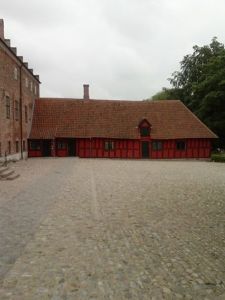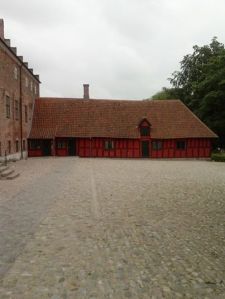The history of the building of Odense (Odense Adelige Jomfrukloster) which hosts the Research center H.C. Andersen, would never pass unnoticed to the foreign viewer, specially for the facade of its entrance, with beautiful red tile, and its roof, just made as imagination recreates the houses of fairy tales.
It is clear that the house stands out from the rest, even though it is located in the area close to the museum dedicated to H.C. Andersen, privileged area to live in, for the beauty of its chalets, decorated with roses and flowers of splendid colors, pedestrian and quiet streets. But the uniqueness of this building, not only lies in its description. Here live together the scientific and academic advance with the history of the city.
The director of the Centre, Johs Nørregaard Frandsen, successor of Johan de Mylius, organized a visit to the building, during the last Conference hold in June, on Children’s literature. There the guests, had the opportunity to see directly, the peculiarities of the old house.
The main building consists of two floors with basement. It has been rebuilt several times, since the XVI century. Residence of bishop, farm, royal house…several transformations, until Jørgen Brahe took over the farm in 1630.
Jørgen Brahe seemed to be a great bibliophile and had a library of around 900 books and 100 manuscripts. This collection was Karen Brahe, relative of Jorgen. Karen Brahe founded a home for unmarried ladies in this same building, in 1717. Eight singles women of the Danish nobility.
Karen Brahe gradually increased to 3,400 books and 1,150 manuscripts library.
At that point of the history, the Centre´s director started to tell the story. He offered a visit to the group of researchers, through the corridors and rooms of the building, talking about the life of those unmarried maidens that lived within these walls, all of them possessing a great culture, not only reduced to local knowledge, but knowing even several languages. They were engaged in the study. Their ages were around 40 and 80 years. At their service they had many maids, not at all happy to live within these walls. Many poems written by them have been found, lamenting their lack of freedom, their nostalgia for the city.
Walls, some rebuilt in our days, continue the footprint of its last form, and several inscriptions show, as if they were notes in an archaeological dig, to which century belongs each color of the Wall.
The building today, has been furnished to accommodate three university research centres, including the one for H.C. Andersen. The Centre´s director explained with good humor, that his current office, was the old room where Lady Karen Brahe received H.C. Andersen, to listen to his compositions and eating chocolates.
Today, the director´s office , has still a box of hocolates.
What still could not be found, despite knowing of its existence, is the ghost. Sometimes doors are mysteriously closed, and nobody knows who or what is doing it…




Leave a comment